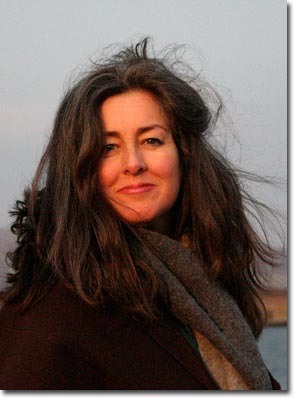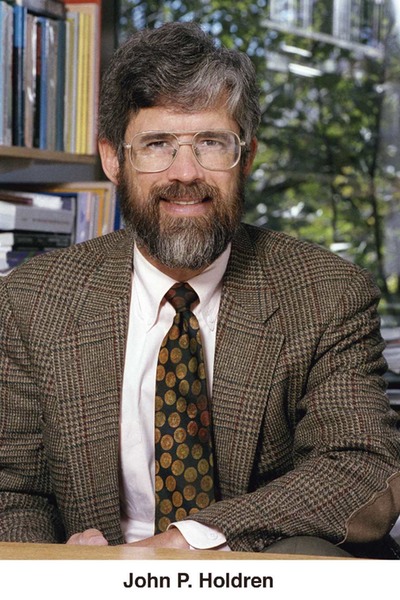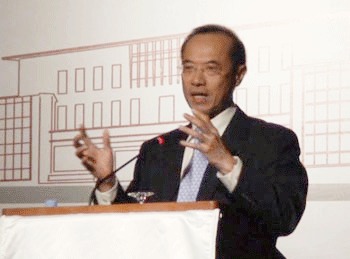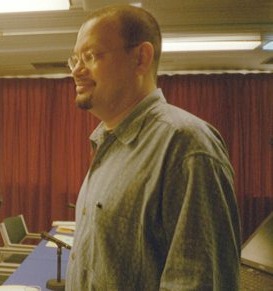Living With a Changing Climate
Climate change is an increasing disaster risk, and preparing for, and reducing the risk of natural hazards is something we all have to do more of. We have to be proactive so that instead of responding to disasters, we mitigate against them.
I was very glad to see Guy Harrison’s article in this weekend’s Cayman Observer, referring to Cayman Brac being devastated by Paloma, as well as to Grand Cayman in hurricane Ivan in 2004. It is imperative that all Small Islands Developing States (SIDS) start to take mitigation measures now to prevent these events from reoccurring. More >>> PDF Document 101 KB
Challenges To Environmentally Responsible Energy Use In Today's Society
ScienceDaily (Dec. 9, 2008) — Remember your first drive down the coast in your beat-up convertible, the ocean breeze tousling your hair, which at the time was still gloriously plentiful and, you hoped, desperately attractive to the person sitting next to you?
If that’s a California cliché, or if you never had a convertible, or if your hair was not that plentiful to start with, think about other lifetime memories: your first flight, your family road trip to Yellowstone, friendships made around the campfire, steam rising off a heated pool on a chilly night, a blast of air conditioning after a day in the withering heat.
Indelible moments and sensations dot our lives like mental sequins. And if you look up to the sky, the carbon atoms used in those moments are still there, each one knocking around with two oxygen buddies, trapping just a little bit of solar heat, forever unavailable in the fossil fuel form that society craves and loathes.
It is not an exaggeration to say that almost all our memories took carbon to make. Whoever invented the famous tag line for cotton growers just had the wrong raw material. Carbon: the fabric of our lives.
Now we are rushing to escape the energy culture as we know it, in order to remake it as we don’t know it. The irony is that a marginal amount of planning – continual improvement in mileage standards, closing of the loophole in those standards that exempted light trucks, steady federal investment in renewable energy – might have alleviated the energy and climate crunch facing us today.
“We could be using half the energy that we’re using,” says political scientist and energy policy expert Mark Bernstein, managing director of the new USC Energy Institute. Launched earlier this year, the think tank aims to build a community of energy and environmental researchers, expand research and education programs, engage outside companies and agencies, and – perhaps most important – help form good policy.
Such policy will have to fit through a shrinking window. Society had more options in the early 1970s, when the concentration of carbon dioxide in the atmosphere was only around 320 parts per million – somewhat higher than the pre-industrial concentration of roughly 280 ppm. Today, with CO2 levels nearing 390 ppm and growing faster than ever, time is a luxury. Predictions of looming “peak oil” – the point at which global oil production starts to decline – add to the urgency.
The energy crisis is not rushing toward the world so much as gaining on it. It’s more a problem from the past than a threat from the future. If only we could have some of that burned carbon back. “We’ve wasted an opportunity,” Bernstein says.
Bernstein’s job at the Energy Institute is to make sure we don’t find ourselves in the same boat 30 years from now. It is the ultimate cross-disciplinary challenge. Today’s policymakers need solid environmental research in a wide range of areas: atmospheric chemistry, land use, biology, physics, materials science, engineering, public policy, health, history – any field that touches on our relationship with the planet and its resources.
It’s a tricky balancing act.
Consider the now-notorious biofuel fiasco. In early 2008, a startling study in the journal Science pointed out what ethanol enthusiasts had overlooked: the huge amount of carbon released when forests are cleared for farming.
According to the study, only sugar cane is worth growing for ethanol. Unfortunately, sugar cane doesn’t grow in Kansas. Ethanol from corn or other plants actually puts more carbon into the air than gasoline, either directly from land cleared for agriculture or from an insidious cascade effect whereby U.S. soybean farmers switch their fields to corn, prompting Brazilian farmers to expand into the Amazon to replace the lost soybeans.
On the other hand, corn ethanol slightly lowers our dependence on foreign oil while enriching Midwestern farmers – a happy coincidence not lost on either political party’s presidential candidates during the Iowa caucuses.
By the time the Science study came out, the federal government had embarked on a bold plan to ramp up domestic ethanol production, largely from corn.
What the plan failed to consider, aside from the environmental cost, was the effect on world food prices. According to Time magazine, the corn needed to make an SUV-sized tankful of ethanol could feed a person for a year. A run-up in grain prices this year failed to derail the plan, despite an appeal by Gov. Rick Perry of Texas on behalf of ranchers blindsided by the skyrocketing cost of feed corn.
In the long term, seductive logic will not solve the energy shortage or abate the greenhouse effect. “Eventually facts count,” says USC chemist George Olah, a 1994 Nobel Prize winner whose achievements include crucial work on clean-burning, unleaded gasoline.
The question is, which facts?
Drawing on experts across the university, the USC Energy Institute stands to become a vital resource for both the research and policy communities. The stakes are high, and the problems complex. Acting correctly is as important as acting quickly.
“This is not just a question of inventing a new technology – it is a matter of changing the way we live and work,” says Randolph Hall, who as vice provost for research advancement guided the institute’s formation. “The Energy Institute is our way of capturing talent across the university toward this mission.”
It was a process that began with the recruitment of key faculty in 2005, when a barrel of oil cost $60 and the Toyota Prius was still an eco-nerd’s car, and culminated this year with an official launch, the installment of Bernstein as managing director and, most recently, the addition of Donald Paul, one of the world’s leading experts on the energy industry, as senior adviser to the provost on energy and technology.
Now comes the hard part.
The Chemists
First, what won’t work. According to Energy Institute experts, besides corn ethanol, you can forget about fusion (still a dream) and hydrogen (too expensive to store and distribute). Nuclear energy, a proven carbon-free technology, is tainted by public anxiety, high capital costs and proliferation fears, and remains something of a last resort. Don’t hold your breath waiting for some miracle of science, either.
“Everybody wants an easy solution,” says USC chemist and longtime Olah collaborator G. K. Surya Prakash. He knows the silver bullet impulse firsthand, having seen his promising but early-stage research cited in overly optimistic articles on another seductive concept: “carbon recycling.”
Prakash and Olah do indeed work on carbon recycling, and for years have been working on the energy problem out of their laboratories in the USC College’s Loker Hydrocarbon Research Institute. Their best prospect is the simplest hydrocarbon: methanol, a synthesis of one carbon, one oxygen and four hydrogen atoms.
Technically, methanol is not an energy source but an energy carrier – a convenient medium for storing and transporting energy.
Oil and gas are energy carriers, too. The ultimate source is the sun, which zaps Earth with what Olah calls “unholy” amounts of energy every day.
“Earth does not have an energy problem,” Prakash explains. “We have an energy-carrier problem.”
While that’s a bit like telling thirsty castaways on the ocean that they have a salinity problem – not really helpful in the here and now – Olah’s and Prakash’s little molecule could be the long-term energy carrier Earth has been looking for.
Unlike hydrogen gas, methanol is liquid at room temperature. Like petroleum, methanol could be transported and pumped in existing tanker trucks and gas stations. And it can be used to make gasoline, jet fuel, dimethyl ether (a diesel substitute) and all kinds of industrial plastics.
“Once you have methanol, you can make everything,” says Prakash.
Other bonuses: Cars can run on methanol with minor modifications. Methanol can be blended with gasoline and ethanol, and it can be made from biomass – organic waste – for less money than ethanol. And, crucially for the reduction of greenhouse gases, it is also possible to make methanol from carbon dioxide and hydrogen. And therefore, in theory, to recycle carbon.
But the story is not so simple, Prakash explains. (Remember, there are no easy solutions.) The caveats: Methanol is not found in nature, so it must be manufactured, which takes energy; methanol has toxic properties; carbon recycling works in the lab, but for commercial use it would need to be scaled up and improved in efficiency.
Caveats notwithstanding, the energy conglomerate UOP-Honeywell saw enough potential in Olah’s and Prakash’s portfolio of “methanol economy” patents that it bought an option to license the lot.
Interest in methanol is not just theoretical, Prakash notes. China is building plants that convert coal directly to a gas mixture, which then is used to make methanol. Such plants still release CO2, though in a concentrated stream that would be easier to collect and recycle.
A new methanol plant in Iceland does much better. The plant uses geothermal steam for power, and makes methanol from CO2 released naturally by the steam vents. That makes the methanol produced fully carbon-neutral.
“Once there is a value for CO2 and CO2 abatement, all these technologies will become commercially attractive,” predicts Prakash, banking on an eventual carbon tax.
Taxing fuel is politically explosive, but some type of “soft” tax may be on the horizon. At a May 2008 forum on climate change policy hosted by USC’s Energy Institute, UCLA public policy scholar J. R. DeShazo sounded a rare note of optimism.
“At the federal level, a remarkable thing has happened,” he told about 100 assembled climate experts. According to DeShazo, both parties in Congress agree on the merits of a cap-and-trade system for regulating carbon emissions.
Cap-and-trade is a foul term to some environmentalists, because it grants explicit permission to pollute. But Adam Rose, research professor in the USC School of Policy, Planning, and Development, who with Bernstein organized the Energy Institute forum, defends the idea.
“You limit the emissions, but then you give people the right to emit something,” he says. “Ironically, this gives them a stake in the environment. Prior to this, polluting was free; but now they have to use a valuable permit for each ton they emit.”
Total emissions would be capped while participants would be allowed to trade emission credits, Rose explains. Theoretically, the emitters who can cut back easily would do so at little cost, and make a profit by selling permits. Meanwhile, the emitters with high costs would buy permits because they are less expensive than mitigating the pollution. While the buyers don’t mitigate, they pay for it to be done by others.
“It’s a way of making people realize there’s a cost in emitting.”
The cost could be higher than people think. Bernstein and geographer Jennifer Wolch, director of USC’s Center for Sustainable Cities, want to quantify the health costs of fossil fuel emissions. They have access to ready data collected by the preventive medicine and environmental health faculty of the Keck School of Medicine of USC.
Led by Keck researchers James Gauderman and John Peters, the group made world headlines in 2007 when it published a study in the British journal Lancet that found stunted lung growth in children living within 500 feet of a freeway. Related studies from the group also found increased rates of asthma and other health problems.
Any accounting of carbon’s cost needs to include the public health burden of vehicle exhaust, Bernstein and Wolch point out.
“People are already paying a big bill, in the form of health effects and the economic burden of these effects – hospital bills, lost economic productivity – on society,” says Wolch, whose effort to tally the bill also involves Keck researchers Rob McConnell and Scott Fruin as well as her geography colleagues Manuel Pastor, Andrew Curtis and John Wilson, and Mansour Rahimi of the USC Viterbi School of Engineering.
Whether they come via carbon tax or cap-and-trade, aggressive cuts in emissions are sorely needed, as climatologist Stephen Schneider noted emphatically at the Energy Institute’s May forum. The Stanford-based scientist was one of the leaders of the Nobel Prize-winning Intergovernmental Panel on Climate Change, which concluded in 2007 that human activities were “very likely” (defined as over 90 percent confidence) changing Earth’s climate.
“We’re on a planetary sustainability train-wreck track, and something has to get done,” Schneider said in his keynote address at USC. “Your institute, I hope, will be at the front lines of that battle. The world badly needs people who do integrative work in the energy field.”
Bernstein, the institute’s managing director, has a résumé built for integrative work. He earned bachelor’s and master’s degrees in applied mathematics from Ohio State before moving to the University of Pennsylvania for his Ph.D. in energy and environmental policy. He got a firsthand look at the nuclear industry while working for a plant construction company, then served on the faculty of Penn’s interdisciplinary energy program.
During the Clinton years, Bernstein worked in the White House Office of Science and Policy, where he launched a grant program to encourage energy innovation in residential construction. (The USC Viterbi School’s Behrokh Khoshnevis, inventor of an automatic system for making a concrete house, is a current grantee.)
Bernstein infuses his activities for the Energy Institute with a nuance rare among energy and environment experts. Take his position on the emotionally charged issue of offshore drilling. He agrees with other experts that any drilling today will not affect oil prices for at least a decade, while also acknowledging that the risk of disastrous spills is quite low.
The more important question, he says, is whether we should leave this oil in the ground and hold it as a strategic reserve. “If we use up all the oil in the United States now, then when the non-OPEC countries begin to run out, the only place to get oil will be the OPEC countries. To me, keeping it in the ground is like an insurance policy.”
A similar pragmatism marks Bernstein’s views on the energy and climate crises. Yes, he says, one could power the entire country on solar panels covering an area a third the size of Texas. Yes, he agrees, our power plants have enough capacity at off-peak hours to recharge plug-in hybrid cars for most U.S. households. But neither option is cost-effective now or in the near future.
Despite Al Gore’s call for a switch to all-renewable energy within 10 years, Bernstein finds it hard to imagine a future without coal and its huge carbon footprint, at least while we shuffle slowly toward alternative energy sources. As a result, he says: “I don’t think we can get away without doing carbon sequestration. We’re not going to cut emissions fast enough.”
Carbon sequestration refers to the process of storing CO2 under ground. Don Zhang and Kristian Jessen, both from USC Viterbi, are the most recent faculty hires in this growing research field (like Rose and Bernstein, Zhang was recruited with support from the Energy Institute).
Zhang is an expert in reservoir simulation and sequestration modeling; Jessen has been studying CO2 injection at the Weyburn oil field, in the Canadian province of Saskatchewan. At Weyburn, waste CO2 from a coal plant is injected under ground and used to force out more oil from the aging field. Jessen called the results promising.
“The technology is there, it’s just very expensive,” he says. “But it’s time that we in the U.S. change the way we look at energy policy.”
As of this magazine’s printing, the Energy Institute was in talks with an outside company and potential international partners to offer USC expertise for test-site studies of carbon sequestration.
On another front, the Energy Institute is engaged in a bold thought-experiment. What would it take to make Santa Catalina Island fossil fuel-free?
The university has a longstanding relationship with the island through the USC Philip K. Wrigley Marine Science Center, a research institute heavily supported by the same Wrigley family behind the chewing gum, Chicago’s Wrigley Field and the Catalina Island Conservancy.
Bernstein helped start Catalina’s Sustainability Action Group, which also includes representatives from the Conservancy, the Santa Catalina Island Company, the City of Avalon, the Chamber of Commerce, L.A. County and Southern California Edison. The group has been exploring ways to achieve energy independence.
The project has yet to be green-lighted, but Bernstein says that weaning Catalina from fossil fuels is a surprisingly realistic goal (golf carts are already the principal means of island transportation, with gasoline used mostly for emergency vehicles and boats). If implemented, the project may serve as a model for hundreds of other communities.
To start, the island could easily achieve a 25-percent reduction in energy demand, Bernstein says.
He cites the work of Thomas Spiegelhalter, an energy consumption expert on the faculty of the USC School of Architecture, who has shown that common-sense measures and existing technologies can reduce energy use dramatically.
The second big gain for Catalina could come from a source we prefer not to think about: sewage. Renowned geobiologist Kenneth Nealson of USC College has been perfecting a genetically engineered bacterium that makes electricity from a diet most foul.
In just the last year and a half, Nealson’s group – including computational biologist Steve Finkel of USC College and mechanical engineer Paul Ronney and material scientist Florian Mansfeld of USC Viterbi – has improved the efficiency of the “bactery” many times over.
Scaled up for household use, it could generate as much electricity from sewage as the typical rooftop solar-panel installation.
Throw in existing methods of energy generation from waste – non-toxic burning of regular garbage, recovery of methane from sewage – some wind and solar installations, maybe a little tidal power, and all of Catalina could go fossil fuel-free, Bernstein says.
It’s been done before. A Danish island described this year in The New Yorker achieved carbon neutrality mostly through a combination of wind power and geothermal heat pumps for home heating and air-conditioning.
The problem is that every situation is unique. A metropolis, a wind-swept rock in the North Sea, a cool rain forest and a desert plain all have different energy needs.
“And this is why we have a hard time selling people [energy] policies,” says Bernstein. “Because it’s not simple. It’s a complicated story.
“We’re going to need some solar,” he says. “We’re going to need some wind; we’re going to need some hydro; we’re going to need some ocean; we’re going to need some biofuels made from non-food crops. We’re going to need a whole load of stuff, and it’s going to have to be a very diverse portfolio.”
For now, solar energy probably remains the darling of the group, at least in consumer appeal. It is clean, direct and easy to understand.
It is also expensive. But maybe not for much longer.
Led by chemist Mark Thompson, USC researchers are working on a new class of flexible solar panels that would be cheap, thin and easy to install on any surface. These panels still trail their stiffer precursors in efficiency, but Thompson’s group hopes to narrow the gap.
“The other side, where we can get an even bigger bang for the buck, is conservation,” he says. His laboratory is working on organic light-emitting diodes (OLEDs) that use even less energy than fluorescent bulbs, contain no mercury or other heavy metals, have a superior color spectrum and last around 25 years.
Thompson’s most recent major study on OLEDs appeared in the journal Nature. Universal Display Corporation, a major lighting manufacturer, has an option to license Thompson’s discoveries.
One can think of conservation as a resource like oil and gas, measurable by the amount of energy saved. If the world’s oil reserves are mostly mapped, its conservation reserves are vast and unexplored. This may be the last frontier in the energy universe.
Energy Meets Information Science
On the suggestion of Dean Yannis Yortsos, researchers from the USC Viterbi School of Engineering have banded together to apply some of the university’s greatest strengths – particularly in computer science and information technology – toward energy conservation.
Some time ago, UPS started planning its delivery routes to avoid left turns. That is a basic example of what information technology can do for conservation.
A core group at USC Viterbi, consisting of electrical engineers Urbashi Mitra and Dan Dapkus, mechanical engineers Roger Ghanem and Fokion Egolfopoulos, and computer scientist Gaurav Sukhatme, authored a white paper laying out a research strategy at the intersection of energy and information science.
“This is an area where Viterbi has a significant track record,” says Mitra. “Furthermore, we believe other organizations have overlooked the impact that information technology can make on this very important area of research: energy.”
The others may soon follow. At a hearing on Capitol Hill this summer, Dan Reicher, the head of Google’s energy and environment unit, expressed ideas similar to the USC group’s.
“The increasing interplay between energy hardware and information software – and the corresponding rise of the Internet and the connectivity it brings – adds to the potential to make and to use energy more productively,” Reicher told policymakers, according to The New York Times. “From smart meters and smart appliances to smart homes and a smart grid, we are poised to significantly advance our ability to monitor and manage energy.”
That list could have included smart engines. Separate from his bactery research, Ronney, with USC Viterbi colleague Martin Gundersen, hopes to squeeze more energy out of the humble but enduring internal combustion engine. The researchers are developing alternative ignition methods to make the air-fuel mixture burn more evenly.
“About 40 percent of your fuel energy actually goes right out your radiator,” says Ronney. “If you could burn fast without turbulence, then you could reverse-engineer the engine” for better fuel efficiency.
Gundersen, an electrophysicist who has collaborated with automaker Nissan, confirms that his “nanosecond pulsed-power” device ignites a larger volume than the traditional spark plug. Unfortunately, the old spark plug has a 100-year head start in research and development. “You really have to have a very robust and not terribly intrusive technology,” he says.
“On the science side, we need to understand better what’s really happening,” he adds, explaining that an improved scientific understanding may lead to new applications, such as improved ignition of alternative fuels.
USC Viterbi’s Egolfopoulos agrees. “The new revolution will come from introducing more science into our applications,” he says.
“What goes on inside an engine is one of the more complicated processes in [physics]. We are trying to understand at the molecular level what happens.
“Engineering will not be able to solve the problems of this century,” he adds – a striking admission from a mechanical engineer. “Without more mathematics, physics and chemistry, the future of energy-related technologies will not be as bright.”
His lab, in collaboration with the lab of USC Viterbi’s Hai Wang, recently solved a fundamental problem by showing that large hydrocarbons – like the ones in jet fuel – break up quickly into smaller molecules during combustion.
It was a big advance with big implications, because it opened the entire universe of gas turbines, including jet engines, to improved computer modeling.
“Understanding every single detail of fuel burning at this level is highly desirable, as it will lead to models that the industry can use to design the new generation of engines,” Fokion explains. “That will save billions of dollars to the industry and may result in a 10- to 20-percent increase of fuel efficiency.”
That would be a huge step forward, since according to Egolfopoulos, “[just] 1 percent improvement in a gas turbine equates to several million cars off the street.”
Egolfopoulos and Wang are now the principal investigators on a major grant for gas turbine modeling from the Air Force Office of Science Research. Their team includes researchers from Stanford, Princeton and Drexel universities, Imperial College of London and the National Institute of Standards and Technology.
In a parallel project, Egolfopoulos turned seed money from the USC Provost’s Office into grants from NASA and the U.S. Department of Energy for the study of biofuel combustion. Like other biofuel researchers, Egolfopoulos has become more skeptical than when he started. His results so far suggest that a biofuel engine produces up to 20 times more carcinogenic aldehydes than a regular gas engine (which, for the record, emits other carcinogens).
“Do you want your kids to inhale aldehydes?” he wonders.
A larger issue for Egolfopoulos is the conversion of farmland. “The moment you start messing with the land, you’re messing with the food chain,” he says. “Then people cannot buy milk for their children; they cannot afford vegetables.” In the long run it may be better to dig up fossil fuels, dirty as they are.
Except, dig them up more efficiently. This has been the aim of the Center for Interactive Smart Oilfield Technologies, or CiSoft – a five-year-old partnership between USC and Chevron. CiSoft pairs industry experts with USC faculty to combine digital media technologies, data analysis techniques and classical petroleum engineering in the hunt for improved and automated oil-production methods.
As chief technology officer for Chevron, Donald Paul was half responsible for establishing CiSoft. His USC counterpart was Provost C. L. Max Nikias, then dean of engineering. Nikias proposed the venture when he met Paul at Chevron headquarters in 1999.
“There was an opportunity to find an intersection between traditionally disconnected areas,” Paul says. “Energy and its intersection with technology is the opportunity, many would argue, certainly for today. It’s at these intersections where you always get the most value.”
Now managed by Iraj Ershaghi, a professor of petroleum engineering in USC Viterbi, CiSoft has become the university’s biggest industry partnership.
It also remains one of a select and carefully chosen university joint ventures at Chevron, Paul says. He calls it “enormously successful” due to its influence across the company, with hundreds of technical, operational and managerial staff adopting CiSoft-driven practices.
Paul remembers meeting a chief mechanic in New Orleans who, thanks to CiSoft technology, was able to simultaneously monitor the maintenance schedules for thousands of compressors operating across the Gulf of Mexico. More significantly, Paul points to the hundreds of Chevron and USC experts who have attended CiSoft’s annual forum.
“The fact that many people are implementing the technologies and practices as quickly as they can tells me you’ve got the right thing,” he says.
The venture also has led to a unique master’s degree in petroleum engineering with an emphasis on smart oilfield technologies – a USC program that, according to Paul, now is steadily pumping out a critical mass of young technical talent.
It seems safe to assume that technology will continue to bring gains in our energy efficiency. The question is, will it make a difference?
“People tend to consume their efficiency gains,” Paul warns.
After the technological gains of the late 1970s, energy prices dropped, so consumers bought more powerful cars and moved into bigger houses farther from cities. Per capita energy use stayed more or less the same. Meanwhile, the population grew, and with it, total energy consumption.
One way to spring the efficiency trap would be to put a floor on the price of energy, to prevent backsliding by individuals and businesses. New York Times columnist Thomas Friedman and others have proposed such an approach, which would amount to a tax that would grow if the cost of energy fell.
The more pressing issue is how to lower the cost of energy in the first place. Paul’s expertise – which includes starting Chevron’s energy diversification portfolio – makes him a valuable counselor on the legislative, scientific and policy aspects of the energy problem.
A graduate of the Massachusetts Institute of Technology, where he earned a bachelor’s in mathematics and a doctorate in geophysics, Paul spent his entire career at Chevron. A theoretician with a practical bent, he moved easily between the company’s research complex in La Habra, Calif., and its operations and development effort in the Gulf of Mexico. After holding several management positions, he was appointed president and CEO of Chevron Canada in the mid-’90s, then became Chevron’s first CTO, a position he held for the past 11 years.
Fossil Fuels
After retiring from Chevron earlier this year, Paul renewed his partnership with Nikias as senior adviser on energy and technology. Part of his charge will be to work with Bernstein on expanding research programs through the Energy Institute. His take on conventional and alternative energy research: “Do it all. Do it now. The world is going to need all the energy we can develop.
“The size of the problem is what most people don’t understand,” he says. “You’re going to need absolutely every molecule. You’re not going to be able to choose.”
The problem with alternative energy is vexingly simple, Paul explains. Renewables like wind and solar pack a lot less energy than oil and gas.
It’s not that alternative energy won’t work. It’s that it takes work. Fossil fuels are easy, and we expect energy to be easy.
Fossil fuel is air conditioning at the touch of a thermostat; alternative energy is passive ventilation, a whole-house fan, heat pump, reflective roof and extra attic insulation, and a house that still is not always quite cool enough.
Fossil fuel is first love; alternative energy is marriage.
We will probably keep flirting with fossil fuels. Like other industry experts, Paul doubts the world can turn away from oil and gas any time soon. After all, fossil energy use is more than 80 percent and very large resources remain – especially for coal.
“And you’d better fix coal while you’re on the way,” he adds.
In a 2007 report to the Secretary of Energy by the National Petroleum Council, Paul (one of its principal authors) identified carbon capture and sequestration as “a critical path” for the United States and China.
But fossil fuels eventually will run out. One could argue that the best stuff, like sweet crude, is already on the way down. Energy companies are grubbing around for dirtier and more carbon-intensive alternatives (see diagram). Alberta’s tar sands are generating millions of barrels of oil, but also spewing millions of tons of greenhouse gases during the laborious extraction process.
At some point, we enter what Paul calls the “then what?” scenario. If the world cannot continue to increase its energy consumption, as it has done from prehistoric times until now, then what?
“Historically, economic growth has a very high correlation with energy consumption,” he says. The consequences of a world without growth would be at least as severe as those of a world without energy, he notes.
Try to imagine a zero-sum economy where a gain by one person must always come at another’s expense. Now try to imagine a civilization that accepts such a proposition.
The Scholars
People tend to think our appetite for growth was literally fueled by oil, and that before World War II – or at least before the Industrial Revolution – Americans lived in pastoral contentment.
The record shows otherwise, says USC’s Peter Mancall, associate vice provost for research advancement and a historian in USC College, where he studies and teaches early American history.
He cites a 1983 book, Changes in the Land, in which author William Cronon traced profound changes in colonial New England’s ecosystem back to British ideas about individual property and man’s dominion over nature.
Cronon famously concluded that in the settlers’ haste to exploit the New World’s vast resources, the “people of plenty” were a people of waste.
Although Mancall can point to alternative views in the 19th century, notably articulated in Henry David Thoreau’s Walden, he finds that the legal system consistently favored exploitation over conservation. “The dominant tradition is one of economic development,” he says.
No matter how far back one looks, at least in American history, there is no large-scale model for a sustainable society. In growth speak, “sustainable” is just another word for “limited,” a concept as American as arugula pie.
In 2006, as part of a precursor initiative to the Energy Institute, cultural scholar Karen Pinkus received a seed grant to study alternative fuels and the American obsession with cars. Disillusionment set in when she realized our culture of consumption transcends individuals.
In her view, the current focus on individual action – buying hybrid autos, switching to fluorescent bulbs – only diverts attention from the real issues.
She argues that even the most appealing green consumer technologies, such as the famous and now-defunct General Motors EV-1 electric car, “are dangerous in that they distract us from issues such as the emissions generated by industrial production, by constant building of new housing, by the transportation of goods in a global economy, agribusiness and so on.”
Pinkus, a professor of Italian, French and comparative literature in USC College, has no single answer to the climate crisis, except to say that as a first step, we should “undo the certainty of common sense” – the belief that our society, as structured, can reduce greenhouse gas emissions to the necessary degree.
Such logic relies on “the same paradigms that got us into this mess,” she says. In other words, society needs a radically new approach.
Whether the world is up to the challenge is another question. In their 2004 financial guide The Oil Factor, noted money managers Donna and Stephen Leeb – whose only agenda presumably is to make good investment calls – advised readers to park some capital in defense stocks in anticipation of the coming “oil wars.”
Then again, maybe we will all learn how to share.
Perhaps the greatest source of comfort is Earth and its capacity to endure. In his presentation at May’s Energy Institute forum, USC College earth scientist Lowell Stott surveyed changes in the planet’s climate over a relatively short time span – a few centuries.
Stott, who served as a reviewer for the Nobel-winning climate change panel, specializes in paleoclimatology; the study of climate change over geological time.
But you don’t have to go back very far to see that Earth’s climate is capable of tolerating far greater change than we have seen to date. Stott presented evidence that the 19th century was far harsher, hotter and drier in California than the past 100 years. In fact, glaciers began receding well before the start of the Industrial Revolution.
“The climate always changes; it always has changed,” he told the audience.
The best we can do, he added, is to understand thoroughly the causes of global climate change, “and by doing so, make better policy choices.”
Good policy. There’s a natural resource that is clean, renewable and no more limited than human ingenuity.
____________________________
Who Are We? A look at the ‘other’: Paper Caymanians and Cultural Violence.
Karl W. Deutsch defines a nation thusly stating;
“A nation is a group of people united by a common mistake regarding its origin and a collective hostility towards its neighbors”
This definition may seem strange, but for those who live on what was originally an uninhabited island by default have ancestors that were immigrants.Scientists, in tracing mitochondrial DNA have found that the entire human race can be traced back to a very small gene pool in southern-most Africa. We are therefore all related, however distantly.
____________________________
Convincing the climate-change skeptics
August 4, 2008 -THE FEW climate-change "skeptics" with any sort of scientific credentials continue to receive attention in the media out of all proportion to their numbers, their qualifications, or the merit of their arguments. And this muddying of the waters of public discourse is being magnified by the parroting of these arguments by a larger population of amateur skeptics with no scientific credentials at all. 
Long-time observers of public debates about environmental threats know that skeptics about such matters tend to move, over time, through three stages. First, they tell you you're wrong and they can prove it. (In this case, "Climate isn't changing in unusual ways or, if it is, human activities are not the cause.")
Then they tell you you're right but it doesn't matter. ("OK, it's changing and humans are playing a role, but it won't do much harm.") Finally, they tell you it matters but it's too late to do anything about it. ("Yes, climate disruption is going to do some real damage, but it's too late, too difficult, or too costly to avoid that, so we'll just have to hunker down and suffer.")
All three positions are represented among the climate-change skeptics who infest talk shows, Internet blogs, letters to the editor, op-ed pieces, and cocktail-party conversations. The few with credentials in climate-change science have nearly all shifted in the past few years from the first category to the second, however, and jumps from the second to the third are becoming more frequent. More >>>
____________________________
President Michel President of Seychelles calls for leadership by the developed nations to address climate change
The 4th Global Conference on Oceans, Coasts and Islands was officially opened on April 9th 2008 in Hanoi, Vietnam with keynote address by the President of Seychelles, Mr James Michel delivered by video to a gathering of over 430 participants from over 71 countries, which included several high-level participants such as the ministers, ambassadors and the CEO of the Global Environment Facility. In his speech, President Michel called for urgent action on the issue of reduction on greenhouse gases, and immediate adaptation to climate change in small island states. He also drew attention to the urgent need to reverse ecological damage of the coastal and marine environment as a result of increasing consumption patterns and destructive methods of exploitation. He highlighted the commitment of Seychelles and the establishment of the Sea Level Rise Foundation to pursue this agenda at the highest global policy level and challenged all participants to indicate how they could implement the global strategy of oceans for the future of our planet. In particular, he proposed the development of a specific work programme on SIDS and climate change.
His speech is reproduced below:
Ladies and Gentlemen,
The sub-prime mortgage crisis and the bankruptcy of a number of financial institutions have been in the headlines for weeks now. We are all at risk from this crisis, and no nation is spared of its consequences. But we face a far greater risk: the bankruptcy of our ecosystem. In our quest for well-being and prosperity, we 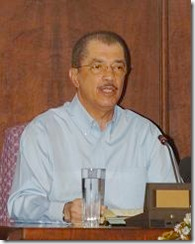 have paid little heed to the well-being of our planet – the spring of life itself. Thus we take for granted our resources. We take for granted water; we take for granted our oceans. And we do so at our own peril.
have paid little heed to the well-being of our planet – the spring of life itself. Thus we take for granted our resources. We take for granted water; we take for granted our oceans. And we do so at our own peril.
We’ve indiscriminately harvested the oceans for food, medicines, mineral resources, leisure etc. without due regard to their role as regulators of freshwater and the climate.
Isaac Asimov once said: “If knowledge can create problems, it is not through ignorance that we can solve them.”
We urgently need a change in policy by the world economic powers. Consumers need to start paying for the real cost of consumption. We need adequate resources to be able to reverse climate change and the ecological damage we have wrought. We need to focus on better alternatives and technologies, some of which are ready for implementation. We need to strengthen our existing institutions to develop an integrated and multi-stakeholder approach to implement the solutions. Above all, we need clear leadership and commitment at the global level. Failure to address ocean issues is failure to address poverty, climate change and sea level rise.
I am calling for leadership by the developed nations - not bargaining - for a global consensus on emissions reductions. The Bali Roadmap on Climate Change should lead to clear action on adaptation, mechanisms to reduce greenhouse gas emissions, and above all allow the deployment of technologies and financing for both adaptation and mitigation measures to developing countries. With this in mind, I aim to push for a clear and time-bound programme of action on climate change adaptation in Small Island Developing States.
In September 2007 I launched the Sea Level Rise Foundation to coincide with the UN Secretary General’s High Level Event on Climate Change. The Sea Level Rise Foundation is a global platform of excellence on adaptation to sea level rise and under the guidance of a team of global leaders we are ready to bring about this programme of action on climate change. I am confident that you will all support the Sea Level Rise Foundation and provide this additional catalyst to bring together knowledge, technologies and resources to address this urgent and crucial issue.
To conclude, I wish to congratulate the Global Forum for keeping the issues of oceans on the global agenda. Our work towards a successful global oceans strategy and policy beyond this present decade is invaluable and fundamental in a domain where leadership is wanting.
Let me challenge all of you gathered here this morning to commit to the implementation of at least one component of this strategy. We can all commit, whether it is with our access to resources, our advocacy work, our network or with our leadership to make a better world for future generations.
The warning signs of a sick planet are upon us. Let us commit ourselves to restoring our planet’s harmony.
Thank you.
____________________________
The cost of oil: implications for the Cayman Islands June 12 2008
By Nick Robson (The Cayman Institute)
Goldman Sachs analysts have predicted $200 per barrel oil by the end of the year. This would mean gas in the Cayman Islands approaching $8.00 per gallon. I do very little driving in a four-cylinder vehicle and spend $100 per month, and can only imagine what it costs the family with numerous children, all active in numerous extracurricular activities.
The problem in the Cayman Islands is that we have no choice; we have to drive, we have no functional public transport system. Yes, we have a bus system composed of independent operators, but this is not a functional public transport system in the true sense of the word.
____________________________
Energy policy is a national concern
The time is now to take energy policy seriously. Shurna Robbins discusses the implications of doing otherwise
In the last five years, the price of oil has quadrupled, hovering around US$100 a barrel for the last few months. Many analysts can actually foresee the price eventually reaching US$200 a barrel. Setting aside for the moment that horrible prospect, the possibility looms of a worldwide shortage of oil, leaving most countries, Cayman included, unable to import enough supplies to meet energy needs.
In an effort to ward off a full-scale energy crisis, a grassroots think tank is asking the government to adopt a national energy policy. And the timing could not be better. The majority of Cayman's electricity needs is met through oil imported from the US. But dwindling reserves globally and continued Middle East tensions could conceivably lead to the US hoarding supplies. The United Nations has called small island states vulnerable to economic and social collapse due to the instability of imported petrol. Certainly, Cayman, with its complete dependence on imported oil for all its energy and transportation needs, fits this description. Jim Knapp, founding member of The Cayman Institute, the aforementioned think tank, sees only one way forward. "If that supply is ever negatively impacted, our entire way of life is in jeopardy. We need to find alternatives to oil by using renewable sources and alternatives where possible," he warns.
Green groups worldwide have been making the same call and people in Cayman should not be fooled for one minute into thinking that there will always be enough oil for such a small place.
Last year, The Cayman Institute made a formal presentation to Cabinet on the need for a national energy policy; the group is following up with a draft that should be submitted to Cabinet within one to three months. The think tank, formed in mid-2006, comprises representatives whose backgrounds include economics, science, law and banking. The proposal is expected to address three major areas - supplies, reducing consumption and environmental impact - and provide a framework to promote conservation and renewable energy through such means as duty waivers, facilitating the use of electric cars and selling back to the power grid excess electricity generated by solar panels. The policy would also include a platform for air quality emissions standards and minimum fuel-efficiency requirements for all cars imported after a certain date.
The drumbeat for a national energy policy coincides with government's own environmental initiatives. Climate change, global warming, renewable energy and a national energy policy all need to be dealt with as part of the same whole. Working on ways to adapt to climate change cannot be seriously considered without touching on a national energy policy or, for that matter, dealing with conservation issues.
For the last three months, a taskforce comprising more than 10 government agencies including departments of the Environment, Hazard Management and Planning has been looking at how to address environmental issues holistically
The taskforce supports Cayman's obligations under the United Nations Framework Convention on Climate Change and the associated Kyoto Protocol to limit greenhouse emissions.
But the best that can be said of all these initiatives is they are a good start. One of the issues the proposal for a national energy policy highlights is that the changes will need to be in place for at least 20 to 30 years in order to have a real impact.
"A national energy policy would allow us to have a national discussion on how we make the energy and how we use it, as well as set a realistic goal in reducing energy consumption from diesel fuel or getting a percentage of energy from renewable sources, say 10%, for example," points out Gina Ebanks-Petrie, Director of Environment Considering that government administrations are by definition an endangered species bound by terms of office, issues requiring long-term solutions may not prove popular for a politician hoping for reelection.
Building new roads and schools offer more tangible evidence to a demanding population than pushing through an energy policy or reducing a carbon footprint. For a national energy policy to gain real momentum, everyone - politicians, administrators and the general populace - needs to understand its importance. To forward a major policy initiative, the government must launch a public education campaign and facilitate public debate.
The benefits of an energy policy may not be felt for decades, with successive administrations spending money to develop necessary infrastructure that will not make any discernible difference during their term in office. To that, we must collectively respond, "Too bad".
Not to put too dramatic a point on it, we are talking about the future of the earth here. Thoughts of reelection, political rivalries and personal legacies need to be set aside. Better to consider what will be left for everyone's children and grandchildren. So when the Cabinet receives the proposal for a national energy policy, the ministers should give the draft the consideration it deserves and act decisively when the time comes.
.







